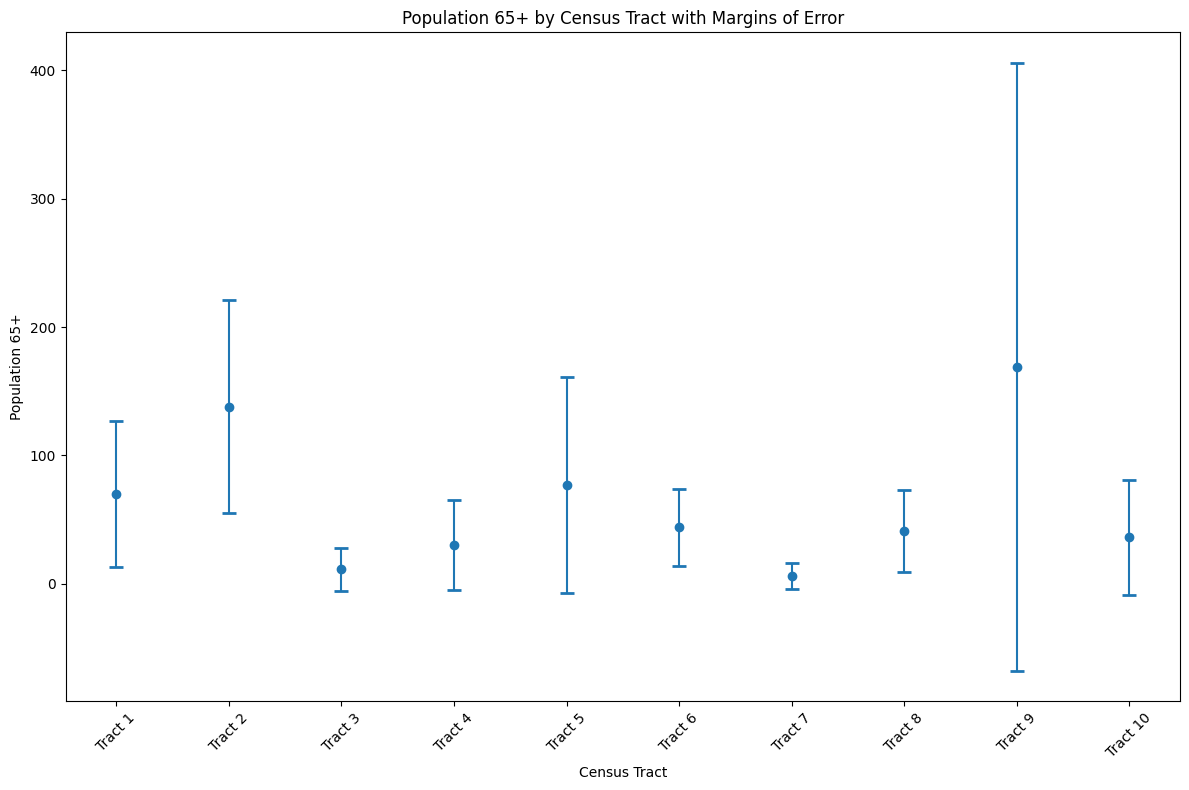Margins of error in the ACS
Understanding and working with uncertainty in American Community Survey data.
import pytidycensus as tc
import pandas as pd
import numpy as np
import matplotlib.pyplot as plt
Census API Key
To use pytidycensus, you need a free API key from the US Census Bureau. Get one at: https://api.census.gov/data/key_signup.html
# tc.set_census_api_key("Your API Key Here")
Ignore this cell. I am just loading my credentials from a yaml file in the parent directory.
import os
# Try to get API key from environment
api_key = os.environ.get("CENSUS_API_KEY")
# For documentation builds without a key, we'll mock the responses
try:
tc.set_census_api_key(api_key)
print("Using Census API key from environment")
except Exception:
print("Using example API key for documentation")
# This won't make real API calls during documentation builds
tc.set_census_api_key("EXAMPLE_API_KEY_FOR_DOCS")
Census API key has been set for this session.
Using Census API key from environment
Understanding ACS Uncertainty
Unlike decennial Census counts, ACS data are estimates with margins of error.
# Example: Aging populations in Ramsey County, MN
age_vars = [f"B01001_0{i:02d}" for i in range(20, 26)] + [f"B01001_0{i:02d}" for i in range(44, 50)]
ramsey = tc.get_acs(
geography="tract",
variables=age_vars,
state="MN",
county="Ramsey",
year=2022,
output="wide",
)
ramsey.head()
Getting data from the 2018-2022 5-year ACS
| GEOID | B01001_020E | B01001_021E | B01001_022E | B01001_023E | B01001_024E | B01001_025E | B01001_044E | B01001_045E | B01001_046E | ... | B01001_022_moe | B01001_023_moe | B01001_024_moe | B01001_025_moe | B01001_044_moe | B01001_045_moe | B01001_046_moe | B01001_047_moe | B01001_048_moe | B01001_049_moe | |
|---|---|---|---|---|---|---|---|---|---|---|---|---|---|---|---|---|---|---|---|---|---|
| 0 | 27123030100 | 70 | 57 | 39 | 111 | 22 | 34 | 59 | 89 | 76 | ... | 25.0 | 40.0 | 30.0 | 26.0 | 58.0 | 40.0 | 41.0 | 47.0 | 65.0 | 49.0 |
| 1 | 27123030201 | 138 | 67 | 229 | 71 | 19 | 84 | 44 | 118 | 84 | ... | 148.0 | 70.0 | 33.0 | 50.0 | 40.0 | 66.0 | 59.0 | 41.0 | 30.0 | 60.0 |
| 2 | 27123030202 | 11 | 15 | 38 | 11 | 0 | 12 | 18 | 0 | 0 | ... | 23.0 | 17.0 | 9.0 | 21.0 | 19.0 | 9.0 | 9.0 | 9.0 | 9.0 | 9.0 |
| 3 | 27123030300 | 30 | 106 | 183 | 94 | 19 | 41 | 47 | 39 | 203 | ... | 87.0 | 55.0 | 31.0 | 32.0 | 40.0 | 46.0 | 89.0 | 60.0 | 39.0 | 24.0 |
| 4 | 27123030400 | 77 | 119 | 58 | 7 | 0 | 11 | 18 | 0 | 86 | ... | 44.0 | 12.0 | 13.0 | 13.0 | 23.0 | 13.0 | 62.0 | 13.0 | 10.0 | 31.0 |
5 rows × 29 columns
# Show cases where MOE exceeds estimate
ramsey["moe_ratio"] = (
ramsey["B01001_020_moe"] / ramsey["B01001_020E"]
) # Example MOE column
print("Cases where margin of error exceeds estimate: 'GEOID'")
print(ramsey[ramsey['moe_ratio'] > 1]['GEOID'].head())
Cases where margin of error exceeds estimate: 'GEOID'
2 27123030202
3 27123030300
4 27123030400
6 27123030601
8 27123030702
Name: GEOID, dtype: object
Aggregating Data and MOE Calculations
When combining estimates, we need to properly calculate the margin of error.
# Custom MOE calculation functions (simplified versions)
def moe_sum(moes, estimates):
"""Calculate MOE for sum of estimates"""
return np.sqrt(sum(moe**2 for moe in moes))
# Aggregate population over 65 by tract
ramsey_65plus = (
ramsey.groupby("GEOID")
.agg(
{
"B01001_020E": "sum",
"B01001_020_moe": lambda x: moe_sum(
x, ramsey.loc[x.index, "B01001_020E"]
),
}
)
.rename(columns={"B01001_020_moe": "moe_sum"})
)
print("Aggregated estimates with proper MOE calculation:")
print(ramsey_65plus.head())
Aggregated estimates with proper MOE calculation:
B01001_020E moe_sum
GEOID
27123030100 70 57.0
27123030201 138 83.0
27123030202 11 17.0
27123030300 30 35.0
27123030400 77 84.0
Visualization with Confidence Intervals
# Create error bar plot showing uncertainty
fig, ax = plt.subplots(figsize=(12, 8))
sample_data = ramsey_65plus.head(10)
x = range(len(sample_data))
ax.errorbar(
x,
sample_data["B01001_020E"],
yerr=sample_data["moe_sum"],
fmt="o",
capsize=5,
capthick=2,
)
ax.set_xlabel('Census Tract')
ax.set_ylabel('Population 65+')
ax.set_title('Population 65+ by Census Tract with Margins of Error')
plt.xticks(x, [f'Tract {i+1}' for i in x], rotation=45)
plt.tight_layout()
plt.show()
